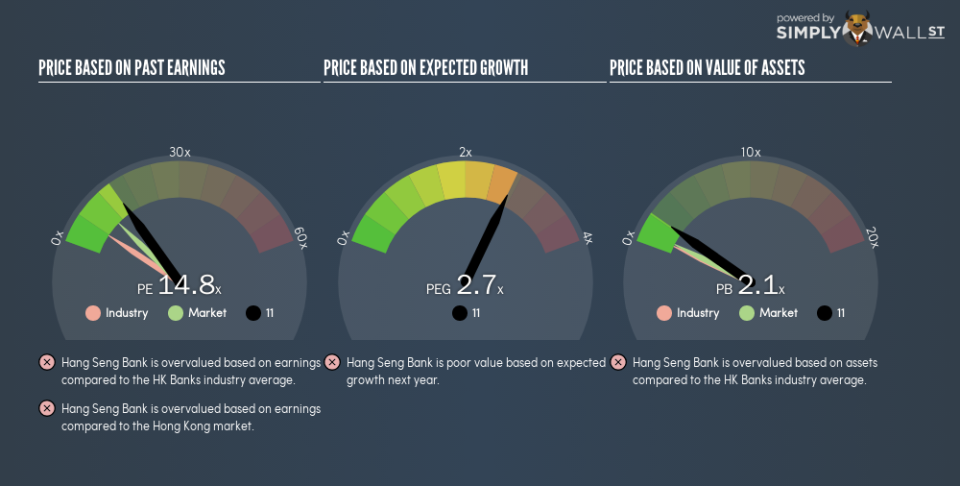Is Hang Seng Bank Limited’s (HKG:11) High P/E Ratio A Problem For Investors?

This article is for investors who would like to improve their understanding of price to earnings ratios (P/E ratios). To keep it practical, we’ll show how Hang Seng Bank Limited’s (HKG:11) P/E ratio could help you assess the value on offer. Based on the last twelve months, Hang Seng Bank’s P/E ratio is 14.81. That means that at current prices, buyers pay HK$14.81 for every HK$1 in trailing yearly profits.
See our latest analysis for Hang Seng Bank
Want to help shape the future of investing tools and platforms? Take the survey and be part of one of the most advanced studies of stock market investors to date.
How Do I Calculate Hang Seng Bank’s Price To Earnings Ratio?
The formula for price to earnings is:
Price to Earnings Ratio = Share Price ÷ Earnings per Share (EPS)
Or for Hang Seng Bank:
P/E of 14.81 = HK$174.3 ÷ HK$11.77 (Based on the year to June 2018.)
Is A High Price-to-Earnings Ratio Good?
A higher P/E ratio implies that investors pay a higher price for the earning power of the business. That isn’t necessarily good or bad, but a high P/E implies relatively high expectations of what a company can achieve in the future.
How Growth Rates Impact P/E Ratios
When earnings fall, the ‘E’ decreases, over time. That means even if the current P/E is low, it will increase over time if the share price stays flat. Then, a higher P/E might scare off shareholders, pushing the share price down.
Hang Seng Bank increased earnings per share by a whopping 27% last year. In contrast, EPS has decreased by 5.7%, annually, over 5 years.
How Does Hang Seng Bank’s P/E Ratio Compare To Its Peers?
The P/E ratio essentially measures market expectations of a company. The image below shows that Hang Seng Bank has a higher P/E than the average (5.8) P/E for companies in the banks industry.
That means that the market expects Hang Seng Bank will outperform other companies in its industry. Shareholders are clearly optimistic, but the future is always uncertain. So investors should always consider the P/E ratio alongside other factors, such as whether company directors have been buying shares.
Don’t Forget: The P/E Does Not Account For Debt or Bank Deposits
It’s important to note that the P/E ratio considers the market capitalization, not the enterprise value. In other words, it does not consider any debt or cash that the company may have on the balance sheet. Hypothetically, a company could reduce its future P/E ratio by spending its cash (or taking on debt) to achieve higher earnings.
Spending on growth might be good or bad a few years later, but the point is that the P/E ratio does not account for the option (or lack thereof).
Hang Seng Bank’s Balance Sheet
The extra options and safety that comes with Hang Seng Bank’s HK$161b net cash position means that it deserves a higher P/E than it would if it had a lot of net debt.
The Bottom Line On Hang Seng Bank’s P/E Ratio
Hang Seng Bank’s P/E is 14.8 which is above average (10.4) in the HK market. With cash in the bank the company has plenty of growth options — and it is already on the right track. So it does not seem strange that the P/E is above average.
When the market is wrong about a stock, it gives savvy investors an opportunity. If the reality for a company is better than it expects, you can make money by buying and holding for the long term. So this free report on the analyst consensus forecasts could help you make a master move on this stock.
Of course, you might find a fantastic investment by looking at a few good candidates. So take a peek at this free list of companies with modest (or no) debt, trading on a P/E below 20.
To help readers see past the short term volatility of the financial market, we aim to bring you a long-term focused research analysis purely driven by fundamental data. Note that our analysis does not factor in the latest price-sensitive company announcements.
The author is an independent contributor and at the time of publication had no position in the stocks mentioned. For errors that warrant correction please contact the editor at editorial-team@simplywallst.com.

